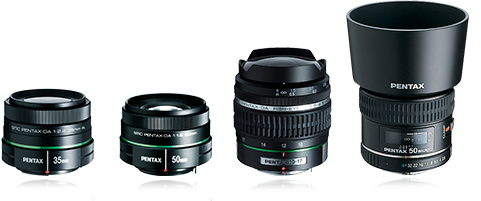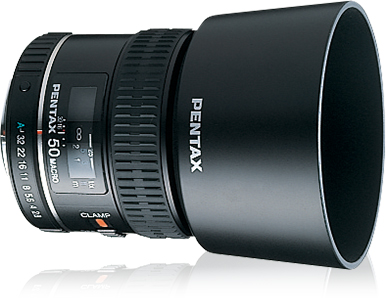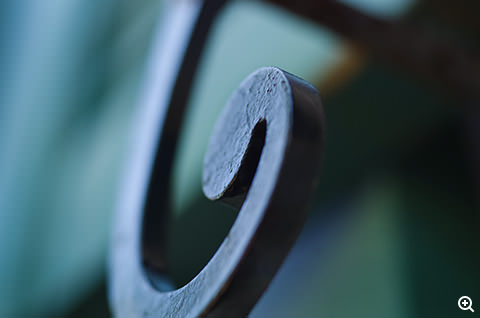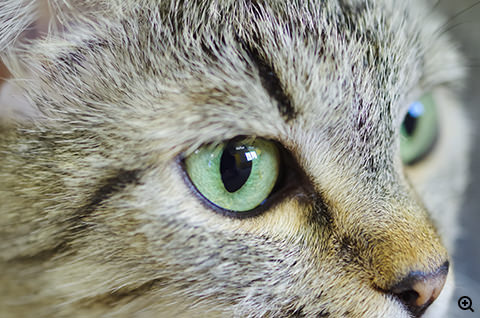Digital interchangeable lens choices are not limited to the almighty and easy-to-use standard kit lens. There are many other distinctive lenses that can expand your enjoyment of photography! Among those lenses, we would especially like to recommend the following four PENTAX interchangeable lenses. We hope you will put their capabilities to good use in a diverse range of situations. (Standard kit lens = The lens which can be purchased as a set with the camera body)

Situation 01
If you find a subject of special interest within a wide landscape, we recommend shooting with the DFA MACRO 50mm F2.8.
It can portray small details more distinctly than the kit lens.
smc PENTAX-D FA Macro 50mm F2.8
The photographer focused his attention on the metal fitting holding the shutter. He took care not to get too close and thus lose the atmosphere created by the fitting. Getting close to the subject is one thing that is fun about using a macro lens, but in some cases you also need to be conscious of the overall balance.
Standard zoom kit lens
For this image, the photographer approached to about the same distance as with the macro lens. The high performance level of the kit standard zoom lens can also be put to good use in close-up photography such as this. Please take a good look at this example and the other examples to reinforce your awareness of the differences between the images of the fixed-focal-length lens and the kit standard zoom lens.
Situation 02
With the DFA MACRO 50mm F2.8, you can concentrate on small details of the human body, such as the fingertips.
When shooting in the macro range, the impression given by the photograph
will change depending on the focal point so you can shoot images with a variety of expressive effects.
smc PENTAX-D FA Macro 50mm F2.8
The photographer’s attention was on the fingers so the focal point was the nail of the middle finger. With the presence of the focal point fully established, the bokeh softly transitions to the background. The fact that the glow of the nail seems stronger here than in the kit standard zoom lens image is evidence of the sharpness of this lens.
Standard zoom kit lens
The differences in the impressions given by the light are evident here because you can compare two photographs taken of the same scene. If there was only one image, the kit standard zoom lens photograph would seem fine on its own. Try changing lenses to experience such differences yourself.
Situation 03
If you want to get closer so you can photograph flowers as big as possible, it is time to try the DFA MACRO 50mm F2.8.
Even the petal veins and other small details are vividly portrayed.
smc PENTAX-D FA Macro 50mm F2.8
The photographer got as close to the flower petal as possible. Here we can see the difference between the special macro lens and the kit standard zoom lens. One way to shoot flowers is to utilize the surrounding atmosphere by including the background, but for close-ups of the parts of the flower, a specialized lens is recommended.
Standard zoom kit lens
This photograph was taken at the minimum shooting distance of the kit standard zoom lens. To portray the softness of the flower petal, it would be nice to get a little closer. For flower photography, a macro lens provides more shooting freedom, thus making it easier to create memorable compositions.
Situation 04
With the DFA MACRO 50mm F2.8, you can focus in on certain features and
discover dimensions not found in the impressions created by standard subjects.
smc PENTAX-D FA Macro 50mm F2.8
In this pupil resides the strength of a wild animal. Whereas the picture of the cat as a whole may be unable to elicit any impression but “cute,” narrowing the view to only a portion of the cat gives a new impression. In order to get close, the basic rule is to let the cat get used to you and then approach slowly.
Standard zoom kit lens
The photographer was looking to capture the expression of this tranquil kitten. The charm of the round pupils produces a very different impression than that of the image captured with the macro lens. Changing lenses creates opportunities for learning about various kinds of images.

smc PENTAX-D FA Macro 50mm F2.8
The distinctive characteristic of a macro lens is its ability to get close to the subject. Discoveries made in close-up observation are filled with the fun and fascination that are key aspects of photography. The shooting will be easier if you first carefully observe the subject with your own eyes and then find the point where you want to concentrate. When you actually get close and the subject looms large, you will find that even a slight shake is noticeable. Possible options include raising the shutter speed or waiting to press the shutter at the moment when the wind stops.







 Cameras
Cameras Lenses
Lenses Camera Accessories
Camera Accessories Sport Optics
Sport Optics
















